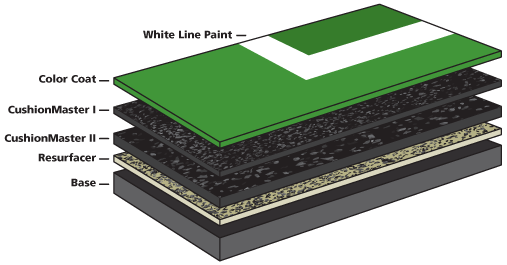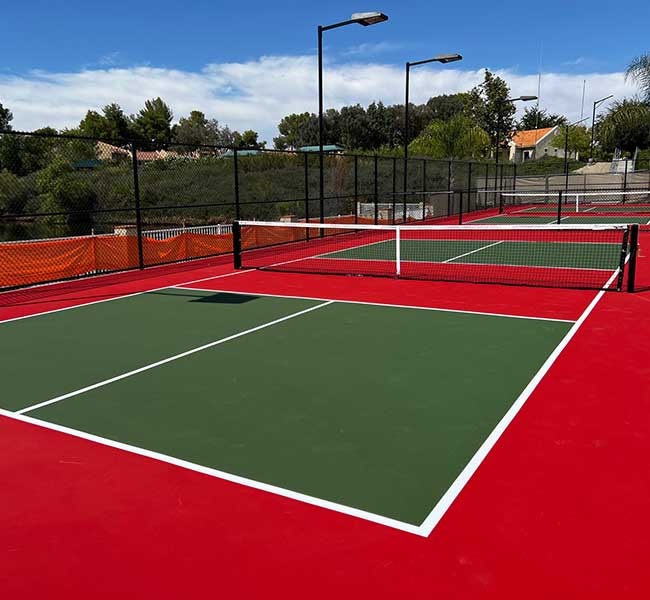Customized Pickleball Court Construction for Residential and Commercial Spaces
Customized Pickleball Court Construction for Residential and Commercial Spaces
Blog Article
Sustainable Practices in Pickleball Court Building You Need To Know
As the appeal of pickleball continues to rise, so too does the demand for lasting techniques in court building and construction. The influence of these techniques extends much past the court itself.
Picking Eco-Friendly Products
Choosing green materials is a critical action in the construction of lasting pickleball courts. The choice of lasting materials not only lessens environmental impact but likewise boosts the longevity and performance of the court. Key products consist of reused rubber for the surface, which offers excellent resilience and shock absorption while drawing away waste from landfills.
Furthermore, using locally sourced materials lowers transport emissions and supports local economic situations. Pickleball court construction. Making use of indigenous hardwoods for secure fencing and seating can give a sustainable aesthetic while guaranteeing resilience against the elements.
Incorporating permeable materials for court structures can even more add to sustainability by permitting all-natural water drain and reducing drainage. These choices not just safeguard neighborhood environments yet also advertise much healthier play atmospheres.
Efficient Drain Solutions
While the choice of environmentally friendly materials is necessary, carrying out effective drainage options is similarly critical for preserving sustainable pickleball courts. Correct drain not just safeguards the court surface from water damage but additionally minimizes disintegration and drainage, advertising ecological integrity.
Efficient water drainage systems can include absorptive paving, which permits water to infiltrate the ground as opposed to pooling externally. This minimizes the likelihood of standing water, which can result in mold and mildew and various other maintenance issues. Furthermore, including tactically put water drainage networks and swales can direct excess water away from the court location, ensuring a completely dry having fun surface and avoiding soil erosion.
Using native plant life in the landscape design around the courts can better boost drainage by taking in excess water and reducing runoff. These plants require less irrigation and promote biodiversity, lining up with lasting methods.
Additionally, it is crucial to frequently preserve the drainage system to guarantee its long-lasting efficiency. This consists of clearing particles and monitoring for obstructions. By focusing on reliable water drainage services, pickleball court constructors can substantially add to the sustainability and longevity of the center, inevitably profiting both players and the environment.
Energy-Efficient Lights Options
As the demand for pickleball remains to expand, integrating energy-efficient lighting choices right into court style has actually ended up being significantly vital for sustainability. Typical lights systems usually consume too much power, adding to greater operational costs and ecological effect. Taking on contemporary, energy-efficient technologies is necessary for both brand-new building and constructions and improvements.
LED (Light Emitting Diode) lighting stands out as a leading option as a result of its longevity and power financial savings (Pickleball court construction). Contrasted to conventional lighting, LEDs Check This Out utilize approximately 75% much less energy and can last up to 25 times longer, substantially reducing upkeep prices. In addition, the directional nature of LED illumination reduces light pollution, ensuring that lighting is concentrated on the court instead of surrounding locations.

Sustainable Surface Alternatives
Discovering lasting surface area options for pickleball courts has gained grip among home builders and players alike. The emphasis on green products not only aligns with the expanding ecological recognition however likewise boosts the efficiency and sturdiness of the courts.
One preferred choice is using recycled rubber, which can be sourced from utilized tires. This product supplies excellent shock absorption, minimizing the danger of injuries for gamers while advertising sustainability. Furthermore, modular floor tiles made from recycled plastics offer an additional sensible option. These floor tiles are very easy to change and mount, and their adaptability enables for various court configurations.
All-natural lawn courts are additionally emerging as a lasting selection, promoting biodiversity and minimizing the heat island impact. Nonetheless, they call for regular maintenance and water, which may not align with all sustainability goals.

Water Preservation Methods

One more reliable technique entails the installment of rain harvesting systems. These systems gather and store rain for use in preserving court surface areas and landscape design. This technique not only preserves drinkable water yet additionally decreases reliance on community sources.
Additionally, utilizing drought-resistant landscaping around the courts is important. Native plants require less water and are better adapted to regional environment problems, thus decreasing total water usage. Furthermore, using effective irrigation systems, such as drip irrigation, ensures that water is supplied straight to plant roots, minimizing dissipation and waste.
Conclusion
Integrating lasting techniques in pickleball court building significantly contributes to ecological conservation and source efficiency. By prioritizing these techniques, the building and construction of pickleball courts can line up with wider ecological objectives while advertising durability and capability within areas.
As the popularity of pickleball proceeds to climb, so too does the need for sustainable methods in court building.Picking environmentally friendly materials is an essential step in the construction of lasting pickleball courts. By focusing on energy-efficient illumination options, pickleball court manufacturers can add to a more sustainable future while fulfilling the needs of stakeholders and players alike.Including sustainable surface area alternatives not only improves the go to my site performance of pickleball courts however additionally paves the means for applying reliable water preservation methods.Incorporating sustainable methods in pickleball court building and construction considerably contributes to ecological conservation and resource performance.
Report this page